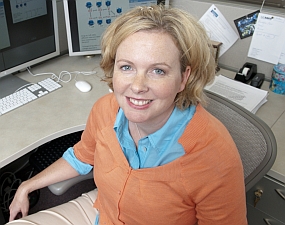Researchers at University of California in Davis have led the development of a computer model to test the effects of medications for arrhythmia — abnormal heart rhythm — before they are given to patients. The work of the team led by biophysicist Colleen Clancy is described in the 31 August issue of the journal Science Translational Medicine (paid subscription required).
Clancy (pictured left) and her colleagues from Davis, Sloan-Kettering Cancer Institute, Cornell, Columbia, and Johns Hopkins universities developed the system to help scientists screen anti-arrhythmia medications early in the drug-development pipeline. The tool is also expected to help physicians more precisely prescribe appropriate interventions to patients.
The need for this kind of system is illustrated by a clinical trial in the 1980s of the arrhythmia drug flecainide, used to treat abnormally fast heart rhythms. Researchers had to stop the trial when they discovered that flecainide more than tripled the risk of sudden cardiac death compared to placebo in patients with irregular heartbeats.
The team started with existing models that simulate the behavior of heart cells during both normal heart rhythms and arrhythmia. The new model defines the key measurable factors needed to simulate the effects of flecainide and another anti-arrhythmic drug lidocaine on their targets. Lidocaine has a strong safety profile and a documented record of clinical data.
The researchers then wrote mathematical formulas to describe the interactions of flecainide and lidocaine with their targeted cells — tiny pores in cell membranes called ion channels that are the basis for cardiac electrical activity. Clancy and colleagues used these models to simulate the effects of these drugs on cardiac rhythms in a 3-D virtual heart.
To confirm the results, the researchers treated rabbit hearts with the two drugs and found that the simulation correctly predicted the heart rates and concentrations at which the adverse effects were seen with the computer model.
“Millions of people each year are affected by cardiac arrhythmias that don’t respond well to medications or that must be controlled with implantable defibrillators,” says Clancy. “Our model will hopefully speed the discovery of new options.”
Read more: Computer Model Helps Pinpoint Cancer Cell Targets
* * *


 RSS - Posts
RSS - Posts
You must be logged in to post a comment.